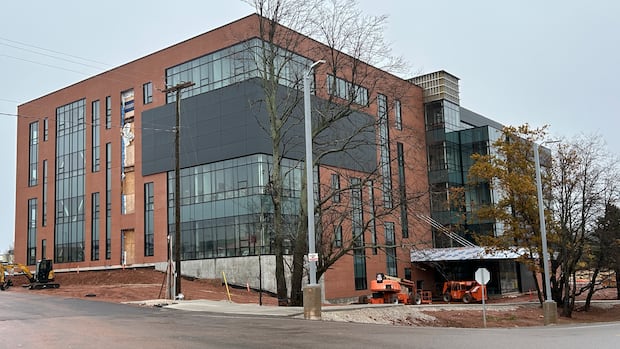Science
New Simulation Centre at UPEI Elevates Medical Training Experience

The University of Prince Edward Island (UPEI) has launched a new Clinical Learning and Simulation Centre (CLSC) designed to enhance the training of future health-care professionals. This facility enables students to learn and practice their skills in a realistic environment before they begin treating actual patients.
Catherine O’Brien, a local actor and director, is part of the team at the CLSC. She brings her experience from a previous role at the University of Toronto, where she participated in a program that utilized standardized patients to simulate medical scenarios. At UPEI, O’Brien plays scripted roles to assist students in developing essential skills such as patient interviews and empathetic communication.
“They will learn how to interview, how to ask the right questions, how to make the patient feel comfortable using empathy,” O’Brien explained during a recent broadcast from the UPEI campus. Through her performances, students practice responding to realistic symptoms and scenarios, gaining confidence and competence in their medical training.
Innovative Training Techniques
The CLSC features a variety of tools aimed at replicating real-world clinical settings. Paul Charles, the centre’s simulation program manager, emphasized the importance of creating an immersive learning environment. The facility includes simulation rooms designed like hospital settings, complete with medication carts and vital signs monitors.
Additionally, the centre utilizes high-fidelity manikins that can simulate breathing, talking, and even experiencing medical emergencies such as heart attacks and seizures. This comprehensive approach helps bridge the gap between classroom education and practical experience, ultimately benefiting patient outcomes and reducing demands on the health-care system.
“Students become more competent and confident, which in turn improves patient outcomes, decreases the demand on the health-care system, and ultimately saves lives,” Charles stated.
The training opportunities at the CLSC extend beyond students. Health-care professionals can also utilize the centre’s advanced equipment and resources to refine their skills. Tammie Muise, the centre’s director, highlighted a new addition known as a “simulation rig.” This mobile unit is designed to simulate ambulance scenarios, allowing health-care workers to practice critical skills in high-pressure situations.
“It’s a trailer that’s pulled by a truck, but in the back of that, it actually is the inside of an ambulance,” Muise explained. This innovation is particularly valuable for simulating urgent medical conditions, such as strokes or heart attacks, where timely intervention is crucial.
Building Connections in Medical Education
As UPEI prepares to welcome its first cohort of medical students, O’Brien has already met some of the future physicians during their orientation. She is eager to engage with them in upcoming training sessions at the CLSC. “I have a few coming up, which I’m excited to get going with,” she said.
The establishment of the Clinical Learning and Simulation Centre marks a significant step forward in medical training at UPEI. By combining innovative technology with experienced personnel like O’Brien, the centre aims to foster a new generation of health-care professionals equipped to meet the demands of modern medicine.
-

 Science3 months ago
Science3 months agoToyoake City Proposes Daily Two-Hour Smartphone Use Limit
-

 Health4 months ago
Health4 months agoB.C. Review Reveals Urgent Need for Rare-Disease Drug Reforms
-

 Top Stories4 months ago
Top Stories4 months agoPedestrian Fatally Injured in Esquimalt Collision on August 14
-

 Technology3 months ago
Technology3 months agoDark Adventure Game “Bye Sweet Carole” Set for October Release
-

 World3 months ago
World3 months agoJimmy Lai’s Defense Challenges Charges Under National Security Law
-

 Lifestyle4 months ago
Lifestyle4 months agoVictoria’s Pop-Up Shop Shines Light on B.C.’s Wolf Cull
-

 Technology3 months ago
Technology3 months agoKonami Revives Iconic Metal Gear Solid Delta Ahead of Release
-

 Technology3 months ago
Technology3 months agoApple Expands Self-Service Repair Program to Canada
-

 Technology3 months ago
Technology3 months agoSnapmaker U1 Color 3D Printer Redefines Speed and Sustainability
-

 Technology3 months ago
Technology3 months agoAION Folding Knife: Redefining EDC Design with Premium Materials
-

 Technology4 months ago
Technology4 months agoSolve Today’s Wordle Challenge: Hints and Answer for August 19
-

 Business4 months ago
Business4 months agoGordon Murray Automotive Unveils S1 LM and Le Mans GTR at Monterey









